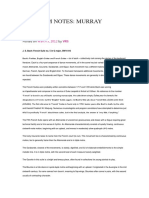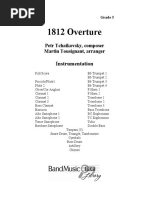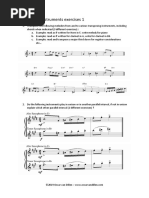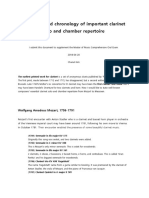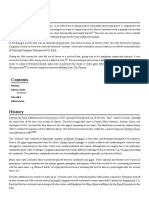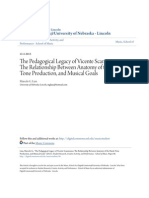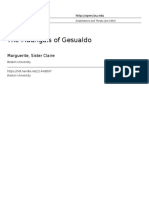Classical Period Notes
Classical Period Notes
Uploaded by
Amber OzolsCopyright:
Available Formats
Classical Period Notes
Classical Period Notes
Uploaded by
Amber OzolsOriginal Description:
Copyright
Available Formats
Share this document
Did you find this document useful?
Is this content inappropriate?
Copyright:
Available Formats
Classical Period Notes
Classical Period Notes
Uploaded by
Amber OzolsCopyright:
Available Formats
Classical Period:
- 1750- 1820
- Preclassical period from 1730 to 1770
- Sebastian Bachs sons: Carl Phillip Emanuel and Johann Christian
(prominent pioneers)
- Was developing when still in baroque period
- Classical is simpler and more melodic
- The term style gallant was applied to this light graceful music
- Light, clear (harmony), homophonic, tuneful melodies (singable), simple
harmonies,
- Common stress on balance and clarity of structure
- Master composers (Joseph Haydn, Mozart, Beethoven)
Melody:
- Classical melodies are among the most tuneful and easiest to remember
- Even highly sophisticated compositions may have a folk or popular
flavour
- Sometimes composers will borrow popular tunes
- Mostly they wrote original themes with a popular character
- Tend to sound balanced and symmetrical
- Classical melodies are frequently made up of two phrases of the same
length
- The second phrase may start sounding like the first, but will end more
conclusively
- Melodic types like these are easy to sing
- Frequently found in nursery rhymes like Mary had a little lamb
- Baroque melodies tend to be less symmetrical, more elaborate and harder
to sing
- Call and response
- Always has a resolution (tonic) always sound complete
- Tonic dominant resolution (tonic)
- Antecedent and consequent (instead of saying call and response)
-
Mood:
- multiple moods
- contrasts
Rhythm:
- classical has lots of different patterns (flexible)
- added lots of new patterns
- has unexpected pauses (unpredictable)
Texture:
- Basically homophonic but flexible
- Shift smoothly or suddenly from one to another
- May begin homophonic and change to poly
Dynamics and the Piano:
- Gradual dynamic changes
- Increased dynamics
- Emotional
- Piano became more prominent than the harpsichord around 1775
- Repetition
The End of the Basso Continuo:
- Gradually abandoned during the classical period
- Classical composers wanted more control
- More music was written for amateurs
Cadenza: chance for player to show off, has the notes written out but no car
lines, can play whatever you want. Cadenzas left to player to make up, no
notes. Early classical- dynamics were not written, left up to the player or an
agreement between the conductor and players. Cadenzas were improvised
by the performers. Performers could add ornaments.
Age of enlightenment: when they looked back to the Greeks and the Romans
and were happy/excited about it. Looked back at the old times and took the
ideas of simplicity and used it.
Sonata Form:
- Became known in the classical period
- Often the structure of the first movement of a concerto, sonata or
symphony
- Refers to the movement of one single movement
- It should not be confused with the term sonata which is used for a whole
composition made up of several movements
- Also used in slow and fast concluding sections
- Exposition: 1
st
subject (tonic), bridge (used to modulation), 2
nd
subject
(closely related key), coda. Sets up a strong conflict between the tonic key
and the new key.
- Development: ideas from exposition are taken and manipulated, lots of
modulations (key changes), intense, unpredictable, themes are treated
differently (different approach to the rhythm). Climatic section, exploring
new ideas.
- Recapitulation: 1
st
subject (tonic), bridge, 2
nd
subject (tonic), coda
(tonic)
- Coda: Tonic key. An even more powerful feeling of conclusion is attained,
by following the recapitulation with yet another section.
You might also like
- A Summary Story of Joseph HadynDocument5 pagesA Summary Story of Joseph HadynNderitu KiraguNo ratings yet
- William Cole About SuiteDocument13 pagesWilliam Cole About SuiteRobby FerdianNo ratings yet
- Program Notes French SuiteDocument2 pagesProgram Notes French Suitewaterwood3388No ratings yet
- Reynolds, R. - Repertoire Is The Curriclum PDFDocument4 pagesReynolds, R. - Repertoire Is The Curriclum PDFJulián Castro-CifuentesNo ratings yet
- Musica Weber Concerto ClarinetDocument1 pageMusica Weber Concerto ClarinetMarco ApazaNo ratings yet
- 00 - Jurassic-Park-conductor-score-compactadoDocument48 pages00 - Jurassic-Park-conductor-score-compactadoSamuel de Souza100% (1)
- History of The Piccolo PDFDocument6 pagesHistory of The Piccolo PDFΡηνιώ ΒούζηNo ratings yet
- 1812 Overture - Arr. Martin Tousignant PDFDocument209 pages1812 Overture - Arr. Martin Tousignant PDFManuelAlves100% (4)
- FBA All-State Saxophone EtudesDocument10 pagesFBA All-State Saxophone EtudesJeremy WilliamsonNo ratings yet
- Faure Sicilienne Cello PDFDocument2 pagesFaure Sicilienne Cello PDFKristyNo ratings yet
- Characteristics of The Classical PeriodDocument3 pagesCharacteristics of The Classical PeriodEusebio Cadag100% (1)
- Beethoven Research ProjectDocument15 pagesBeethoven Research Projectapi-300103643No ratings yet
- Understanding of MusicDocument19 pagesUnderstanding of MusicTanner EliasNo ratings yet
- Music AppreciationDocument7 pagesMusic AppreciationMichi AmamiNo ratings yet
- Short Guide To Writing Program NotesDocument3 pagesShort Guide To Writing Program NotesWayne Frederic TeoNo ratings yet
- Mozart Symphony No 40Document2 pagesMozart Symphony No 40rpaskett100% (5)
- Brass 2023 Prac Syllabus 10feb23Document184 pagesBrass 2023 Prac Syllabus 10feb237gsykx6wqn100% (1)
- Melodic Devices (GCSE Music)Document1 pageMelodic Devices (GCSE Music)Steven JohnNo ratings yet
- Department of Education: Republic of The PhilippinesDocument16 pagesDepartment of Education: Republic of The PhilippinesDaisy E Gonzalvo100% (1)
- Overview of Western Musical HistoryDocument18 pagesOverview of Western Musical HistoryBrian Williams100% (1)
- Berlioz: Symphonie Fantastique: Movement, I (For Component 3: Appraising)Document7 pagesBerlioz: Symphonie Fantastique: Movement, I (For Component 3: Appraising)Amir Sanjary ComposerNo ratings yet
- Unit 6 17 Beethoven Septet in E Flat Op 20 Movement IDocument6 pagesUnit 6 17 Beethoven Septet in E Flat Op 20 Movement IAlison Cooper-WhiteNo ratings yet
- Detailed Course Outline: An Introduction and OverviewDocument6 pagesDetailed Course Outline: An Introduction and OvervieweugeniaNo ratings yet
- Transposing Instruments Exercises 1Document2 pagesTransposing Instruments Exercises 1Musicalite MusicaliteNo ratings yet
- Medieval Music - Early Developments of Polyphony PDFDocument2 pagesMedieval Music - Early Developments of Polyphony PDFLurian S. Lima100% (1)
- Y9 Minimalism (MUW)Document30 pagesY9 Minimalism (MUW)Zenan KWAN100% (1)
- Licentiate of The Royal Schools of Music (LRSM) Music Performance (Trombone)Document7 pagesLicentiate of The Royal Schools of Music (LRSM) Music Performance (Trombone)McJayJazzNo ratings yet
- Clarinet Repertorie Bullet Example (Chanul Kim)Document8 pagesClarinet Repertorie Bullet Example (Chanul Kim)Chanul KimNo ratings yet
- Suite (Music) : History Dance Suite See Also ReferencesDocument3 pagesSuite (Music) : History Dance Suite See Also ReferenceshurlyhutyoNo ratings yet
- Rimsky KorsacovDocument4 pagesRimsky KorsacovJuan David Cuastumal Ortega100% (1)
- Western MusicDocument21 pagesWestern MusicAlexander Nasa Villasoto100% (1)
- Chopin Ballade No1 - 230301 - 130050844Document11 pagesChopin Ballade No1 - 230301 - 130050844Reynard KristonoNo ratings yet
- HaydnDocument2 pagesHaydnRogerNo ratings yet
- The Sonata, Continued: The Other Movements: Theme and VariationsDocument9 pagesThe Sonata, Continued: The Other Movements: Theme and Variationsnyancat009No ratings yet
- The Symphonies of HaydnDocument9 pagesThe Symphonies of HaydnSimon MowattNo ratings yet
- Piano Syllabus 2013 - 2014Document2 pagesPiano Syllabus 2013 - 2014Tanya TazzioliNo ratings yet
- LigetiDocument1 pageLigeticudankaNo ratings yet
- As Notes For Set WorksDocument93 pagesAs Notes For Set WorksAndrewcassidy100% (1)
- Guide To The Baroque SonataDocument3 pagesGuide To The Baroque SonataOthoniel MejiaNo ratings yet
- The Pedagogical Legacy of Vicente Scaramuzza: The Relationship Between Anatomy of The Hand, Tone Production, and Musical GoalsDocument55 pagesThe Pedagogical Legacy of Vicente Scaramuzza: The Relationship Between Anatomy of The Hand, Tone Production, and Musical GoalsIvana Gomez100% (1)
- Dvorak New World Symphony AnalysisDocument8 pagesDvorak New World Symphony Analysisjesseowen1627No ratings yet
- The 7 Composers of Romantic PeriodDocument12 pagesThe 7 Composers of Romantic PeriodJeffreyLamsis100% (2)
- The Nineteenth-Century Piano ConcertoDocument25 pagesThe Nineteenth-Century Piano ConcertoJacksonNo ratings yet
- JS BachDocument45 pagesJS Bachapi-3743066100% (1)
- Aqa Gcse Music SpecificationDocument34 pagesAqa Gcse Music Specificationapi-228727621No ratings yet
- Music.9-12.Musical Elements - Listening For FormDocument4 pagesMusic.9-12.Musical Elements - Listening For Formtlarocca1No ratings yet
- HOUG, James. The Evolution of Double Reed Playing in SpainDocument7 pagesHOUG, James. The Evolution of Double Reed Playing in Spaincristinafa88gmailcom100% (1)
- 100 Questions - GCSE Edition: NO. DateDocument4 pages100 Questions - GCSE Edition: NO. DateEENo ratings yet
- Medieval Period (700-1400) : NeumesDocument4 pagesMedieval Period (700-1400) : NeumesMarites ParaguaNo ratings yet
- DipABRSM Program NotesDocument3 pagesDipABRSM Program NotesdennnNo ratings yet
- Gcse Music Revision List 2019Document2 pagesGcse Music Revision List 2019vcecilia2002No ratings yet
- Dvorak AntoninDocument11 pagesDvorak Antoninapi-3743066No ratings yet
- Time To Teach: The Warm-Up As The Foundation of Your Orchestra RehearsalDocument4 pagesTime To Teach: The Warm-Up As The Foundation of Your Orchestra RehearsalMilad AziziNo ratings yet
- Forms and GenreDocument4 pagesForms and GenreJulio Gándara GarcíaNo ratings yet
- Music Analysis - TANGO NEUVODocument2 pagesMusic Analysis - TANGO NEUVOjoshup7No ratings yet
- Baroque Opera: It All Started HereDocument10 pagesBaroque Opera: It All Started HereAdamNo ratings yet
- A Most Savory Cocktail: Milhaud's Scaramouche As An Assemblage of Compositional TechniquesDocument11 pagesA Most Savory Cocktail: Milhaud's Scaramouche As An Assemblage of Compositional TechniquesEstebanNo ratings yet
- ABRSM Music Theory Grade 4 by Sharon Bill A4Document19 pagesABRSM Music Theory Grade 4 by Sharon Bill A4Esther AJAYINo ratings yet
- Traditional Romanian Music and DanceDocument4 pagesTraditional Romanian Music and Danceapi-672251753No ratings yet
- Levels V-VI and All State NYSSMADocument4 pagesLevels V-VI and All State NYSSMAtlarocca1No ratings yet
- General KnowledgeDocument54 pagesGeneral KnowledgeluhhhNo ratings yet
- Viva VoceDocument11 pagesViva Vocekirankrishna25100% (1)
- 5 TubaDocument1 page5 TubarobertoNo ratings yet
- Quarter 3 Reading Materials in MusicDocument6 pagesQuarter 3 Reading Materials in MusicElisha HernandezNo ratings yet
- BR 5 TetDocument2 pagesBR 5 TetvickyNo ratings yet
- Lengnick Catalogue PDFDocument31 pagesLengnick Catalogue PDFGinger BowlesNo ratings yet
- Bach, Johann Sebastian - Jesu, Joy of Man - 'S Desiring, BWV 147 PDFDocument4 pagesBach, Johann Sebastian - Jesu, Joy of Man - 'S Desiring, BWV 147 PDFHosea RandNo ratings yet
- Canon in Re - Pachelbel, JohannDocument6 pagesCanon in Re - Pachelbel, JohannMeisterNo ratings yet
- Mussorgsky - Tablouri Dintr-O ExpozițieDocument53 pagesMussorgsky - Tablouri Dintr-O Expozițiesschipor_1No ratings yet
- Concierto de AranjuezDocument27 pagesConcierto de AranjuezCristiano MoreiraNo ratings yet
- Mozart 5 Divertimentos k439b No2 II MenuettoDocument3 pagesMozart 5 Divertimentos k439b No2 II MenuettololloencNo ratings yet
- Pentatonix Daft Punk Medley For Sax QuartetDocument17 pagesPentatonix Daft Punk Medley For Sax QuartetEmanuele GanzaroliNo ratings yet
- Maximilian SteinbergDocument5 pagesMaximilian SteinbergDmitry KalinichenkoNo ratings yet
- Curriculum Map in Music 9: St. Elijah Christian Institute of Technology Foundation, Inc. Ocana, Carcar City, CebuDocument30 pagesCurriculum Map in Music 9: St. Elijah Christian Institute of Technology Foundation, Inc. Ocana, Carcar City, CebuCloue Faye I. Basallo100% (1)
- FluteDocument15 pagesFluteDannBjornNo ratings yet
- Arcangelo Corelli La FolliaDocument3 pagesArcangelo Corelli La FolliaRiccardo VisiniNo ratings yet
- (Canon in D) Easy PianoDocument2 pages(Canon in D) Easy Pianoluiscovar1166100% (1)
- Oxford University Press Music & Letters: This Content Downloaded From 207.162.240.147 On Wed, 07 Sep 2016 23:08:26 UTCDocument4 pagesOxford University Press Music & Letters: This Content Downloaded From 207.162.240.147 On Wed, 07 Sep 2016 23:08:26 UTCMariló Soto MartínezNo ratings yet
- Bach Cello SuitesDocument1 pageBach Cello SuitesZachary HarriottNo ratings yet
- 9 Music K To 12 MELCS With CG Codes SplitDocument3 pages9 Music K To 12 MELCS With CG Codes SplitJonathan Siriban BiasNo ratings yet
- Vivaldi Concerto in A Minor RV356 in BB TrumpetDocument2 pagesVivaldi Concerto in A Minor RV356 in BB TrumpetAlex AlmeidaNo ratings yet
- Viola Transcrip. Suite 2 PDFDocument74 pagesViola Transcrip. Suite 2 PDFMiriam Ortíz100% (5)
- Vocal Collections For HS Voices PDFDocument7 pagesVocal Collections For HS Voices PDFNicoletta Colombo50% (2)
- Don Carlo Gesualdo2Document50 pagesDon Carlo Gesualdo2Clau gomes100% (1)
- Claude DebussyDocument16 pagesClaude DebussyDiana GhiusNo ratings yet
- Jackson 5 Medley - Arr. T.hoshideDocument117 pagesJackson 5 Medley - Arr. T.hoshideSandra Nieto100% (2)
- MArcia Funebre BeethovenDocument17 pagesMArcia Funebre BeethovenRodrigo BelmarNo ratings yet


